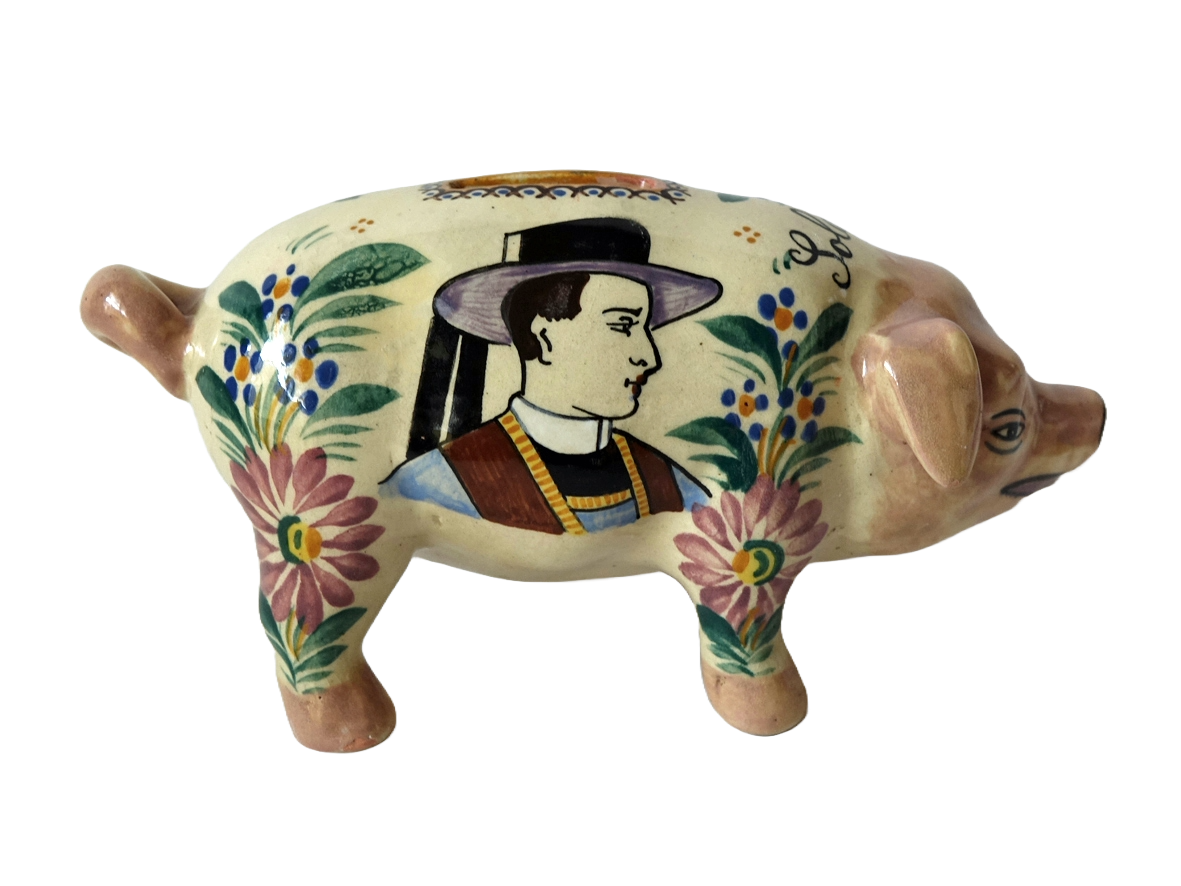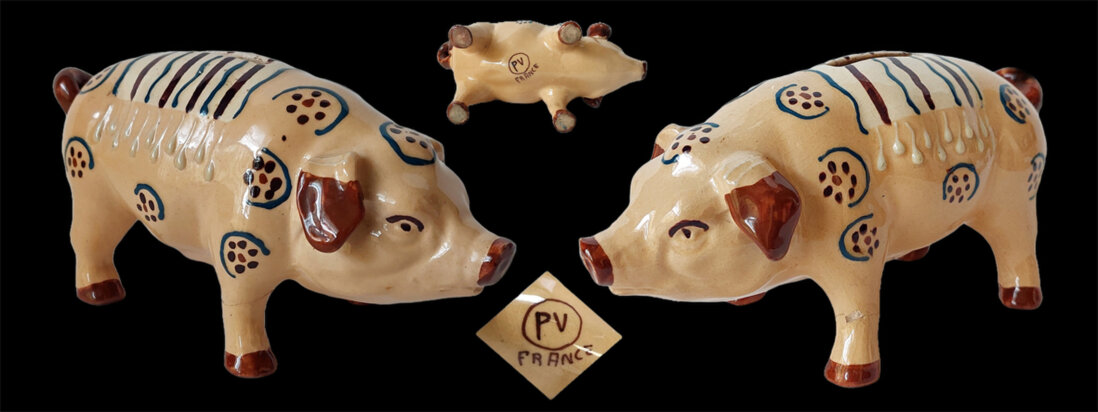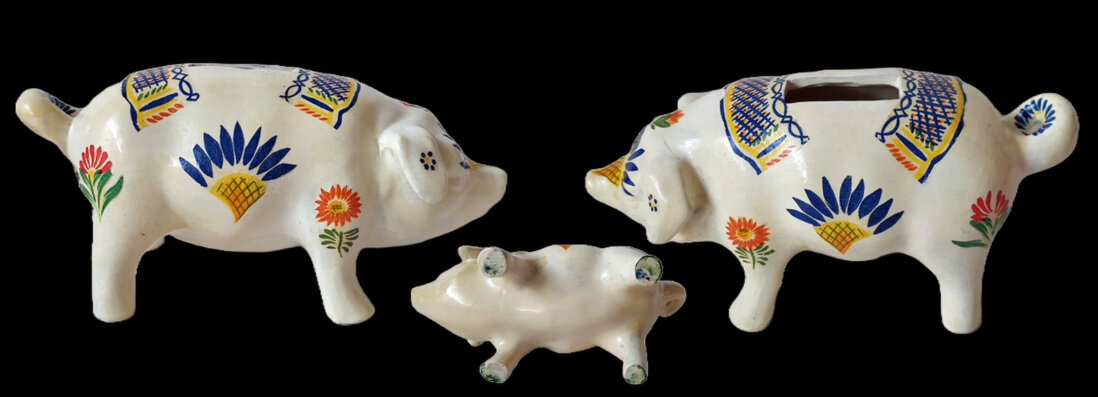France
Collection 1

Quimper
Quimper was the location of several faïenceries, the oldest and (for piggy banks) most important of which is the Grande Maison HB-Henriot. Well-known artists and potters played a part in their history, starting around 1690, of what has come to be called Quimper Faïence to distinguish it from other French or Breton pottery. Not so interesting for our pig piggy banks, at least I don't know any Quimper pig piggy banks from 1690 to 1771.
- The HB brand was registered in 1771, H van Hubaudière and B van Bousquet (the founder of the first faïencerie in 1690). In 1776 a split takes place and Henriot is created, followed by a third faïencerie by the family called Porquier.
- 1870 is an important year for the Quimper tradition, because that is the start of the design of the famous Breton peasant and peasant woman on pottery. A design by Alfred Beau (Porquier).
- In 1913 Henriot acquires competitor Porquier and takes over all copyright and molds (hence one similar mould for the pig piggy banks of the various faïenceries).
- Between 1922 and 1932, Jules Verlingue (HB) and Louis Bolloré register the brand 'VB Normandie'.
- Between 1920 and 1940, HB and Henriot are 'leading' when it comes to Quimper pottery. Henriot carries the HR brand (H from Henriot and R from Riou, Henriot's wife at the time). HB uses HB as a brand. Which leads to confusion (even now). Through a legal procedure, Henriot is ordered from 1922 on to replace the HR brand by Henriot in full.
- In 1968 HB and Henriot merge to form the well-known HB-Henriot.
- In 1983 the company almost went bankrupt and a number of restarts took place.
- Today, HB-Henriot produces in Locmaria, a suburb of Quimper. The famous pig piggy banks are only for sale online. And occasionally at outlet stores……
- The piggy banks made in mould 393 are all 20 cm length.

My oldest Quimper is this one. HB. Mould 33. This mark was used in the period 1883-1904. At that time, the painters used their own 'morse code'. Length 20 cm.
HB Quimper. Signature used between 1922-1968. Period of this: 1950-1968. Man and woman in typical Breton costumes. The man on the piggy bank "bears" the name Solange, the woman the name Marcel. That way they are connected.

Not traditional, but "real" Quimper 393
And at the end of 2024 I discovered an unbranded piggy bank that clearly came from mould 393 and a the same Quimper type 393 with PV as the brand in the USA.

I found this piggy bank on eBay.com (the American eBay). Mould 393 is obvious. Could be from HB, but also from Henriot. But the brand is PV-France. How about that?
It turns out that Henriot (and/or HB) also worked with subcontractors. PARRY & VIEILLE was one of the companies involved in the production of Quimper faience. The collaboration with Henriot/HB took place around the 1920s to 1950s. This was a period when many pottery factories in Quimper collaborated or merged to optimize production and distribution. At P&V, the piggy banks were simply provided with the Henriot or HB mark. But here it seems (note: my theory!) that they also had their own line based on mould 393. They then decorated it according to their own insight. Because these did not meet Henriot / HB's standard, they made it their own brand. This seems to me a logical explanation for the PV brand under a Henriot/HB piggy bank. Period: 1920-1950. Length 20 cm.
It turns out that Henriot (and/or HB) also worked with subcontractors. PARRY & VIEILLE was one of the companies involved in the production of Quimper faience. The collaboration with Henriot/HB took place around the 1920s to 1950s. This was a period when many pottery factories in Quimper collaborated or merged to optimize production and distribution. At P&V, the piggy banks were simply provided with the Henriot or HB mark. But here it seems (note: my theory!) that they also had their own line based on mould 393. They then decorated it according to their own insight. Because these did not meet Henriot / HB's standard, they made it their own brand. This seems to me a logical explanation for the PV brand under a Henriot/HB piggy bank. Period: 1920-1950. Length 20 cm.

An unbranded, "signed all over" Quimper/HenRiot. 20cm long. A less refined type of clay was used for this, it feels heavier and is somewhat coarser. And the motif/decoration is far from the traditional one we are used to from Quimper. Furthermore, the money slot is very wide; Whether this is conscious or an "accident" is impossible to say. It is also not clear who the maker is. The French seller marked it as Devres, but I doubt that.

Quimper special editions
In addition to piggy banks out of mould 393, HenRiot (1922-1968) also made two other types. The grey one without a traditional décor (!) was probably made for export to the USA, an important customer of HenRiot. The other has the traditional Breton peasant décor. Of which I have both the farmer and the farmer's wife in my collection.

The couple is united!

Eastern France
In Lorraine the cities of Lunéville, Sarreguemines and Saint-Clement are the original centers of the earthenware industry. From 1812 on, and throughout the following century, it was the seat of Lunéville "Keller and Guerin" (Société KG). In 1922, the factories of Lunéville and St. Clement's were bought by Edouard Fenal, who also owned the factory in Badonviller. The Fenal family expanded their ‘empire’ in 1979 , buying Sarreguemines where since 1968 Lunéville pottery is produced with the name "KG Lunéville". In December 2006 the Fenal Group merges with the group "Faïence et Cristal de France consisting of the factories St. Clément, Niderviller, Vallerysthal and Portieux, all factories established in the 18th century with a prestigious past. This new group . "Terres d'Est" preserves the heritage, the ancient tradition, of Lorraine earthenware.

Miscellaneous
Pondering on French pottery one immediately thinks of Limoges porcelain. But there is much more French pottery and often in comparison to Limoges severely under valuated. Superb pottery is or was made in: Lorraine (Lunéville, Saint Clement, Sarregemines), Northern France near Lille (St Amand, and Hamages Orchies), Alsace, Rhone-Alpes, Bourgogne (St Uze), Quimper, Bordeaux, etc.

Revol, Saint Uze. Art Deco, dated ± 1920-1939. High 13,5 cm. Seated gentlemen with their umbrella. Symbol of dignity.
Reference book for French Tirelires
Hunting for piggy banks for over 50 years means that I have a large variety in my collection. Collecting more of the same type in different colour variations is not an option and not that exciting. That's why from the past years I focused on antique piggy banks and rediscovered France. I knew few to nothing about the origin of French piggy banks until I discovered the book 'Tirelires – Barbotine, grès et porcelaine' of Maryse Botero in 2007. A book with a lot of information about the often former ‘manufactures’.






















































